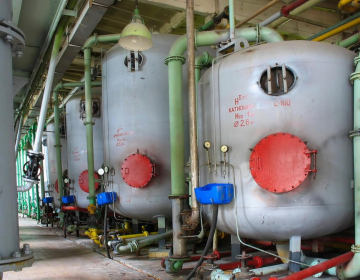In November, former vice president Joe Biden emerged as the winner of the presidential election. Similar to previous administration transitions, the Chemical Industry will stand ready to engage with bipartisan leaders in Congress to help drive constructive solutions for a more sustainable future that will better serve all Americans.
The Chemical Industry will undoubtedly share President-elect Biden’s commitment to a clean environment, a healthy workforce and sustainable manufacturing practices. After all, the US chemical industry is five times safer than the general manufacturing sector, and has reduced emissions of air pollutants by 50 percent since 2001.
“The Chemical Industry in the USA will continue to collaborate internally, and with Washington, to explore options that better serve customers and end-use markets while protecting public health and the environment," says Vince Malone, Senior Consultant and Chemical Segment Leader at Antea Group USA. "Safety, Quality and Environmental Stewardship are core principles that drive product development and innovation among chemical manufacturers.”
TSCA Update
The Toxic Substances Control Act is a United States law, passed by the United States Congress in 1976 and administered by the United States Environmental Protection Agency, that regulates the introduction of new or already existing chemicals. On June 22, 2016, President Obama signed the Frank R. Lautenberg Chemical Safety for the 21st Century Act, which made updates to the Toxic Substances Control Act, most notably, requiring the EPA to conduct formal reviews of new and existing chemical substances in commerce and determine whether a substance presents an unreasonable risk of injury to health or the environment under the conditions of use.
So, what’s new for the year ahead, and how does it impact your business?
The Biden Administration will arrive as implementation of TSCA enters a critical stage. In its efforts to implement the 2016 TSCA Amendments, the USEPA is engaged in extensive efforts to:
- Complete risk evaluations of the First 10 substances;
- Proceed with risk evaluations for the Next 20 substances;
- Issue final TSCA framework guidelines; and
- Issue rules that will streamline the USEPA review process for pre-manufacture notices.
Biden’s EPA is likely to proceed with the First 10 chemicals that have been evaluated under amended TSCA. The USEPA has concluded that five out of the First 10 chemicals pose unreasonable risks. And it proposed the same conclusions for the six remaining substances. Chemicals posing unreasonable risks must be regulated under TSCA.
However, the Biden Administration could have a significantly different approach for evaluating chemical risk than the Trump Administration, with fundamental material impacts on all ongoing efforts. Substantial regulatory changes to the TSCA risk evaluation process are possible, including the following:
- Expanding the breadth of potential exposures and routes of exposure considered (instead of limiting to the areas of greatest concern);
- Expanding the range of chemical uses considered;
- An increased focus on sensitive populations to broaden environmental justice policy; and
- Potential to conduct workplace risk evaluations without considering personal protective equipment.
These potential policy changes could impact, not only the upcoming Next 20 risk evaluations but also the ongoing First 10 risk evaluations. The EPA has already finalized five of the First 10 risk evaluations, and has said that it plans to finalize the remaining five in early 2021. Even if the EPA completes all First 10 risk evaluations, the Biden administration could request the EPA initiate “supplemental” risk evaluations to address the items bulleted above.
Regardless of what happens with the First 10 risk evaluations, it is virtually certain that the Biden administration will take a substantially broader approach for the Next 20 substances. “Expanding the risk evaluation process is a concern for the chemical industry. Many chemical manufacturers lack confidence that the current EPA has sufficient Industrial Hygiene staff and expertise to effectively and efficiently address real-world metrics impacting worker exposures. This could possibly lead to unreasonable risk findings that will increase chemical restrictions and requirements under TSCA, further delaying the chemical evaluation process,” concludes Malone.
PFAS Considerations
The USEPA is also preparing to issue a draft significant new use rule that will limit PFAS use, as part of a broader debate regarding the regulation of “forever chemicals.” Similarly, chemicals and risks continue to play material roles in the development and implementation of other USEPA regulations in various stages of development, and litigation, under the Clean Air Act.
Changes to TSCA’s new chemicals program in 2021 may be more subtle, however they will be equally profound. Consistent with a more conservative approach, Biden’s EPA is expected to shift toward requiring a more complete understanding before approving new chemicals for use. That is expected to translate into additional EPA requests for upfront data from submitters who seek approval for new substances. Overall, the Biden Administration’s more stringent approach to risk analysis will further slow efforts to win USEPA approval of new chemicals.
It is anticipated that the Biden Administration will move quickly to establish regulations on forever chemicals in water and other media. The Office of the President Elect has already issued a policy statement indicating that President Biden will tackle PFAS pollution by designating PFAS as a hazardous substance, setting enforceable limits for PFAS in the Safe Drinking Water Act, prioritizing substitutes through procurement, and accelerating toxicity studies and research on PFAS. Additionally, the USEPA is currently evaluating appropriate drinking water concentration limits for two “forever chemicals” -- perfluorooctane sulfonate (PFOS) and perfluorooctanoic acid (PFOA).
Finally, environmental and scientific organizations are urging the Biden Administration to make structural changes to the way chemical exposure risks are assessed within and beyond TSCA. Requests include unifying cancer and non-cancer risk assessments, placing greater emphasis on environmental justice concerns and sensitive populations, further assessing conflicts of interest and increasing the focus on research data. The Biden Administration will likely be open to pursuing structural changes to chemical risk assessment, which would have impacts across a full range of EPA programs.
Whatever decisions the Biden administration takes, it appears the USEPA chemicals office will need to increase resources and staff as evidenced by deadlines the office has missed in releasing the First 10 chemical risk evaluations under the Trump Administration. A proposed rule revising TSCA fees is currently under review by the White House. Most NGO Organizations feel that increasing fees that chemical manufacturers pay would ensure the EPA has the resources needed to conduct robust and comprehensive risk evaluations.
With careful planning and a solid organizational structure, most chemical manufacturers will continue to effectively respond to the increase in regulatory activity and oversight under the Lautenberg Act, and Antea Group is committed to assisting our clients in meeting their regulatory obligations.
Contact us to learn more about TSCA compliance support today.
Want more news and insights like this?
Sign up for our monthly e-newsletter, The New Leaf. Our goal is to keep you updated, educated, and even a bit entertained as it relates to all things EHS and sustainability.
Get e-Newsletter


